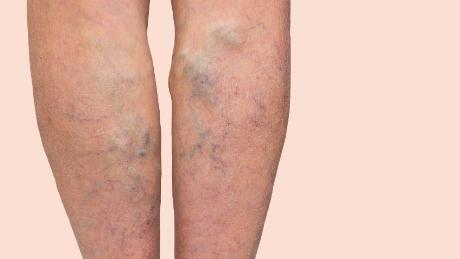Story highlights
- Height is a genetic risk factor for varicose veins, a study finds
- Finding this genetic link may lead to better treatments
(CNN)In what researchers are calling "the largest genetic study ever performed" on varicose vein disease, a Stanford University School of Medicine study found a person's height to be a significant risk factor for developing varicose veins.
"We not only found an association between height and varicose veins, but the genetic studies we did showed a causal link," said cardiologist and study author Dr. Nicholas Leeper, an associate professor of surgery and cardiovascular medicine at Stanford. "That suggests that the genes and pathways that drive human height are also likely to be causing varicose veins."
Dr. Cheryl Hoffman, medical director for the UCLA Health-Manhattan Beach Interventional and Imaging Center, singled out "the strong genetic link."
"We know that varicose veins and venous disease are genetic, so it makes sense there might be something wrong with the vein walls that runs in families," said Hoffman, who was not involved in the research.
What are varicose veins?
Swollen, twisty purple veins that often look like tree branches just under the surface of the skin, varicose veins can cause aching pain, throbbing and discomfort.
"A lack of movement, being pregnant, overweight, all this puts pressure on the veins in the lower part of the body, and some blood begins to pool instead of traveling up the veins back to the heart," Hoffman explained. "Varicose veins are an extension of that."
Typically found in the legs, the unsightly protrusions are usually benign but can lead to more serious heath issues, such as bleeding, sores or ulcers and blood clots.
The most serious complication is deep vein thrombosis, or DVT, a blood clot in one or more of the deeper veins. Deep vein thrombosis is typically characterized by cramping pain, redness and swelling at the site, although it can occur with no symptoms. DVT needs immediate treatment; if one of the clots breaks loose, it can travel through the bloodstream and cause a life-threatening pulmonary embolism, or blocked blood flow in the lungs.
About 20% of all adults will develop varicose veins, according to the US National Library of Medicine. The Society for Vascular Surgery estimates that up to 35% of Americans have the condition, which most commonly affects women, especially those with multiple children, and the obese.
A theory proved
Using data from the UK Biobank, a genetic repository of 502,619 people ages 40 to 69, the Stanford researchers identified 30 genetic regions associated with varicose veins. Then they used an artificial intelligence machine model to look for any previously unknown risk factors.
Out of 2,716 predictors of varicose veins, the machine model confirmed many currently established risk factors: age, family history, gender, weight, pregnancy, smoking, hormone therapy and a history of deep vein thrombosis or surgery on the legs.
But, Leeper said, the connection to height was surprising.
To verify that finding, researchers used a statistical technique known as Mendelian randomization to see whether height was an actual cause. Sure enough, the analysis showed that it was.
"A handful of studies from 20 or 30 years ago hinted at a link," Leeper said. "We don't understand it. Perhaps taller people are affected by gravity, or there could be something in the vessel wall itself. What is happening, we just don't know."
Get CNN Health's weekly newsletter
Sign up here to get The Results Are In with Dr. Sanjay Gupta every Tuesday from the CNN Health team.
The AI model also found another previously unknown risk factor: bioimpedance, a measure of how well the body resists electric flow. Fat, for example, is highly resistant; blood is less so.
Treatment for varicose veins is limited to surgical interventions, such as vein catheterization or laser treatment, along with lifestyle changes such as compression stockings. Standing all day or sitting for long periods of time, such as on a plane, should also be avoided, as it can increase blood pressure inside of veins.
The researchers hope their results shed light on the underlying biology that changes in people at risk for varicose veins and allow scientists to develop new therapies.








